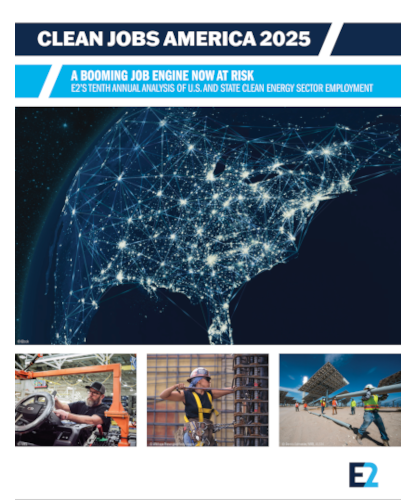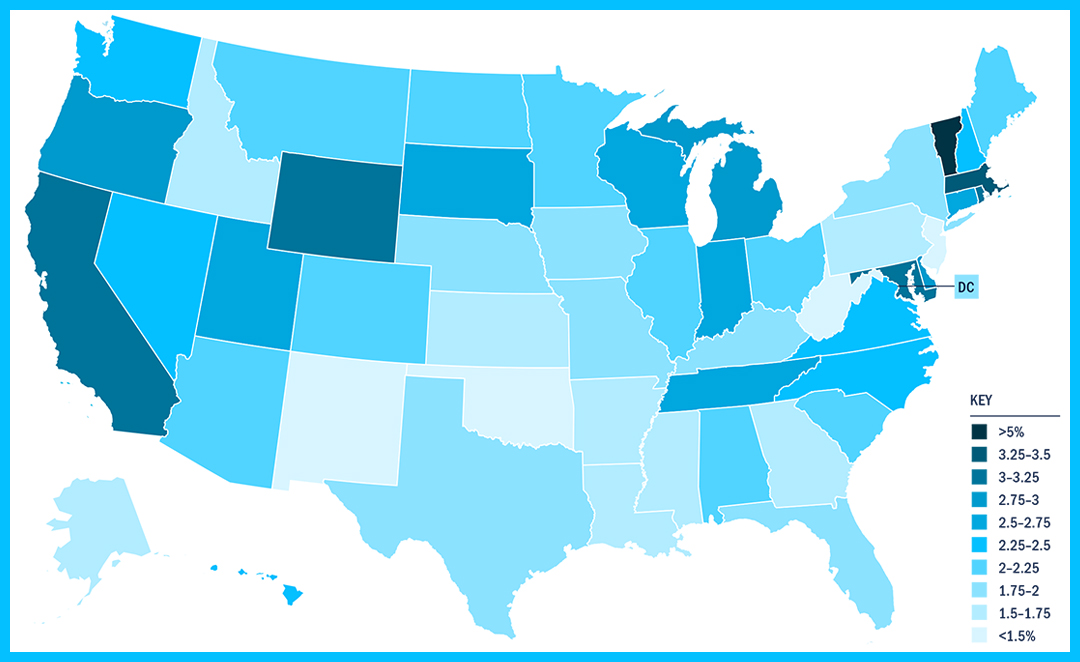
10TH ANNUAL ANALYSIS OF U.S. CLEAN ENERGY EMPLOYMENT
Despite experiencing its slowest pace of growth since 2020, the clean energy industry’s growing importance to the broader economy was more apparent than ever in 2024. This trend was expected to continue as clean energy accounted for larger and larger shares of energy industry jobs and the nationwide workforce. But recent policy decisions to revoke incentives, cancel permits, and target the industry with new red tape and legal hurdles threatens future growth and, increasingly, the health of the U.S. economy at-large.
Still, clean energy jobs grew 2.8 percent in 2024, adding nearly 100,000 new jobs and outpacing the rest of U.S. employment (0.8 percent) more than three times over.2 The growth of clean energy jobs also far outpaced job growth across the rest of the energy industry. The number of Americans working in clean energy related occupations today now exceeds the number of jobs in oil, gas and coal by more than three to one. Just eight states are still home to more fossil fuel workers than clean energy workers.
The pace of job growth is unmatched in the energy sector. Since 2020, the sector has added more than 520,000 new jobs, growing 17 percent overall—much faster than the rest of the economy and far surpassing job growth in the fossil fuel, gas and diesel motor vehicle, and the rest of the energy industry. The sector accounted for 82 percent of all new energy jobs added in 2024 and now accounts for 42 percent of nationwide employment in energy and motor vehicles. Key drivers include demand for electric vehicles, the rapid deployment of battery storage and smart grid technologies, and continued strength in energy efficiency upgrades.
At the end of 2024, more than 3.5 million Americans were employed in clean energy occupations, spanning renewable generation, battery and storage, energy efficiency, biofuels, grid modernization and clean vehicles industries. These jobs now represent a significant share of the U.S. workforce—including seven percent of all new jobs added in 2024—and are spread across every state, strengthening both local economies.

Most Clean Energy Jobs | INDUSTRY
Most Clean Energy Jobs | REGION
Most Clean Energy Jobs | SECTORS
*Total clean energy jobs includes employment in energy efficiency, renewable energy, clean fuels, clean vehicles, and storage and grid modernization
Clean Energy Jobs Breakdown
Clean Energy Jobs
by Sector
Main
CE Sectors
Value Chain
Added Sectors
Total Energy
Economy 2023
Clean Energy Jobs
by Sector
Main
CE Sectors
Overall Clean Energy Jobs
| National Rank | State | Total Jobs | Agriculture | Utilities | Construction | Manufacturing | Trade | Professional Services | Other Services |
|---|---|---|---|---|---|---|---|---|---|
| 1 | California | 552,987.00 | 1,163 | 10,122 | 225,769 | 77,364 | 57,790 | 133,720 | 47,059 |
| 2 | Texas | 281,468.00 | 2,116 | 7,052 | 134,462 | 35,361 | 26,348 | 54,250 | 21,879 |
| 3 | Florida | 184,022.00 | 524 | 2,347 | 119,810 | 9,903 | 16,296 | 21,080 | 14,062 |
| 4 | New York | 180,062.00 | 430 | 3,904 | 58,430 | 13,964 | 13,354 | 72,468 | 17,512 |
| 5 | Illinois | 132,220.00 | 2,511 | 1,889 | 49,913 | 27,232 | 9,613 | 31,425 | 9,638 |
| 6 | Michigan | 127,854.00 | 417 | 934 | 30,420 | 66,227 | 6,864 | 17,714 | 5,277 |
| 7 | Massachusetts | 126,862.00 | 27 | 1,411 | 43,537 | 12,134 | 19,403 | 41,391 | 8,958 |
| 8 | Ohio | 121,112.00 | 591 | 1,221 | 52,754 | 32,519 | 10,337 | 16,661 | 7,028 |
| 9 | North Carolina | 113,123.00 | 1,124 | 1,708 | 41,324 | 19,360 | 7,540 | 34,234 | 7,831 |
| 10 | Pennsylvania | 104,528.00 | 741 | 1,626 | 46,091 | 22,120 | 12,733 | 12,402 | 8,815 |
| 11 | Virginia | 102,649.00 | 575 | 1,133 | 51,871 | 7,586 | 5,925 | 28,162 | 7,396 |
| 12 | Indiana | 90,046.00 | 1,680 | 788 | 35,966 | 32,071 | 6,216 | 9,306 | 4,018 |
| 13 | Tennessee | 88,154.00 | 382 | 1,386 | 37,057 | 24,905 | 8,603 | 11,343 | 4,478 |
| 14 | Georgia | 85,598.00 | 1,068 | 1,317 | 43,854 | 13,182 | 8,963 | 11,117 | 6,096 |
| 15 | Maryland | 84,870.00 | 147 | 1,042 | 55,735 | 3,656 | 4,290 | 13,679 | 6,322 |
| 16 | Washington | 83,142.00 | 400 | 1,493 | 44,615 | 6,251 | 5,741 | 19,922 | 4,718 |
| 17 | Wisconsin | 75,072.00 | 798 | 603 | 31,498 | 24,133 | 6,920 | 7,140 | 3,980 |
| 18 | Colorado | 69,896.00 | 696 | 1,309 | 21,379 | 1,886 | 3,121 | 37,099 | 4,407 |
| 19 | Arizona | 66,710.00 | 167 | 1,175 | 36,284 | 4,580 | 3,210 | 16,650 | 4,644 |
| 20 | Minnesota | 63,888.00 | 1,363 | 1,288 | 34,926 | 6,914 | 5,676 | 10,228 | 3,492 |
| 21 | New Jersey | 62,299.00 | 39 | 1,089 | 26,053 | 9,219 | 9,741 | 9,278 | 6,879 |
| 22 | Missouri | 61,108.00 | 592 | 776 | 30,403 | 13,030 | 4,868 | 7,656 | 3,784 |
| 23 | Oregon | 57,923.00 | 2,343 | 1,049 | 26,931 | 11,170 | 3,269 | 9,150 | 4,009 |
| 24 | Utah | 48,669.00 | 3 | 505 | 29,725 | 2,230 | 4,624 | 8,494 | 3,087 |
| 25 | South Carolina | 48,274.00 | 690 | 568 | 17,113 | 12,086 | 11,298 | 3,608 | 2,911 |
| 26 | Alabama | 47,751.00 | 854 | 855 | 19,778 | 13,633 | 2,892 | 7,632 | 2,108 |
| 27 | Connecticut | 45,494.00 | 136 | 474 | 19,918 | 3,594 | 5,271 | 12,369 | 3,731 |
| 28 | Kentucky | 40,492.00 | 539 | 397 | 13,753 | 16,619 | 2,758 | 4,717 | 1,709 |
| 29 | Nevada | 36,768.00 | 0 | 773 | 23,251 | 2,244 | 2,657 | 5,688 | 2,155 |
| 30 | Iowa | 33,627.00 | 1,957 | 481 | 17,355 | 6,005 | 3,554 | 2,302 | 1,973 |
| 31 | Louisiana | 32,443.00 | 588 | 270 | 20,551 | 3,195 | 2,206 | 3,878 | 1,755 |
| 32 | Kansas | 27,025.00 | 518 | 542 | 7,511 | 2,145 | 1,182 | 13,814 | 1,313 |
| 33 | Oklahoma | 25,552.00 | 88 | 614 | 13,706 | 3,837 | 1,624 | 4,162 | 1,521 |
| 34 | Mississippi | 22,474.00 | 956 | 386 | 10,712 | 5,346 | 1,489 | 2,429 | 1,156 |
| 35 | Arkansas | 22,450.00 | 767 | 463 | 11,127 | 3,860 | 2,106 | 2,587 | 1,541 |
| 36 | Nebraska | 21,122.00 | 1,134 | 426 | 11,074 | 2,417 | 2,240 | 2,596 | 1,235 |
| 37 | New Hampshire | 17,431.00 | 17 | 216 | 7,809 | 2,886 | 1,468 | 3,826 | 1,209 |
| 38 | Vermont | 16,194.00 | 18 | 319 | 5,612 | 1,524 | 2,683 | 4,720 | 1,319 |
| 39 | District of Col. | 15,990.00 | 0 | 206 | 5,577 | 13 | 709 | 8,342 | 1,143 |
| 40 | Idaho | 15,628.00 | 654 | 283 | 7,385 | 918 | 807 | 3,934 | 1,646 |
| 41 | Rhode Island | 15,262.00 | 0 | 207 | 7,538 | 939 | 2,390 | 3,268 | 921 |
| 42 | New Mexico | 14,073.00 | 242 | 312 | 6,430 | 1,750 | 646 | 3,948 | 745 |
| 43 | Maine | 14,046.00 | 422 | 282 | 7,305 | 871 | 872 | 2,657 | 1,637 |
| 44 | Hawaii | 13,656.00 | 592 | 288 | 7,771 | 281 | 811 | 3,158 | 754 |
| 45 | Delaware | 12,981.00 | 37 | 181 | 8,888 | 549 | 822 | 1,781 | 722 |
| 46 | South Dakota | 12,555.00 | 527 | 199 | 6,656 | 1,785 | 1,643 | 902 | 844 |
| 47 | Montana | 11,054.00 | 221 | 216 | 6,174 | 332 | 971 | 2,393 | 746 |
| 48 | West Virginia | 10,797.00 | 440 | 98 | 7,345 | 1,014 | 1,124 | 424 | 352 |
| 49 | North Dakota | 9,508.00 | 1,626 | 179 | 4,562 | 527 | 1,668 | 596 | 349 |
| 50 | Wyoming | 8,704.00 | 46 | 107 | 5,941 | 514 | 913 | 844 | 340 |
| 51 | Alaska | 5,485.00 | 33 | 137 | 3,139 | 208 | 533 | 1,146 | 290 |
| United States | 3,561,095.00 | 33,076 | 56,328 | 1,588,498 | 577,371 | 318,332 | 737,555 | 249,936 |
Jobs Added Since 2020
Percent of All New Energy Jobs Added
Clean Energy Manufacturing Jobs
Percent Faster Job Growth than Rest of U.S.
Credit: NREL/Dennis Schroeder
Go Deeper on Clean Energy Jobs
August 14, 2024
A survey of more than 900 clean energy companies say the federal Inflation Reduction Act (IRA) has dramatically boosted their businesses, and that repealing or rolling back the landmark climate and clean energy law would result in substantial losses, layoffs, and closures.
Clean Economy Works | An Economic Impact Analysis of Major Clean Energy Projects Announced Through Two Years of the Inflation Reduction Act
October 15, 2024
The 338 large-scale clean energy projects announced in the two years of the IRA are estimated to, if completed, create 621,000 new jobs, add $237.5 billion to U.S. GDP, create $169.4 billion in new wages for workers, and generate nearly $50 billion in new tax revenue.
October 19, 2022
33 percent of all billion dollar disaster costs since 1980 in the U.S have occurred in the last 5 years, totaling $765 billion in losses and more than 4,500 deaths from 2017 to 2021—were nearly eight times higher than in the 1980s.
October 22, 2020
Clean energy jobs paid 25% more than the national median wage in 2019 and were more likely to include health care and retirement benefits.
Credit: NREL/McKinstry
About this Report
The analysis expands on employment data collected and analyzed by the BW Research Partnership for the 2025 U.S. Energy and Employment Report (USEER) released by the Department of Energy (DOE). The USEER analyzes data from the U.S. Bureau of Labor Statistics (BLS) Quarterly Census of Employment and Wages (QCEW) to track employment across many energy production, transmission, and distribution subsectors. For more information on the methodology click here.
This is the 10th annual Clean Jobs America report produced by E2 based on analysis of the USEER, which was first released by the DOE in 2016. E2 was an original proponent of the DOE producing the USEER, and was a partner on the 2018, 2019, and 2020 reports produced by the Energy Futures Initiative (EFI) and National Association of State Energy Officials (NASEO) after the DOE chose not to produce a USEER.
WHAT JOBS WE INCLUDE
We include are jobs in solar energy, wind energy, combined heat and power, bioenergy, non-woody biomass, low-impact hydro power, geothermal, electric vehicles, hybrid electric vehicles, plug-in hybrid vehicles, hydrogen and fuel-cell vehicles, clean energy storage, smart grid, micro grid, grid modernization, advanced biofuels, and energy efficiency including ENERGY STAR® and high efficiency appliances, efficient lighting, HVAC, renewable heating and cooling, and advanced building materials. The clean energy occupations covered in this report span economic sectors including agriculture, utilities, construction, manufacturing, wholesale trade, professional services, other services.
WHAT WE DO NOT INCLUDE
We do not include are jobs of workers who may spend some of their time in clean energy but a plurality in another energy sector. For example, workers employed by an excavation business might spend the majority of their time grading and preparing drilling pads for oil or gas rigs, but they also might spend a portion of their time preparing sites for wind turbines or large solar installations. If clean energy does not account for a plurality of their work, those workers would not be counted as being employed in the clean energy economy but would instead be counted as part of another energy sector. We also do not include any jobs in traditional transmission and distribution due to an inability to accurately segment out workers by electricity source, despite many of those jobs being critical to the increased electricity from renewable energy used by the grid. Lastly, we do not include jobs in corn ethanol, woody biomass, large or traditional hydroelectric, and nuclear because of environmental issues associated with those industries. Jobs in retail trade, repair services, water or waste management, and indirect employment or induced employment are also not included.






